Last week I stopped by one of my favourite op-shops between errands, and had a rummage in their $3 fill-a-bag fabric bin. I didn’t find any fabric, but I did find something even better.
This:
This is a hussif, hussuf, hussy, huswif, hussive or housewife (so, basically any way you can spell a contraction of housewife).
A hussuf is a fabric case for carrying all your sewing implements. The most common form is a long rectangle of padded fabric that rolls up into a small packet, so that you can easily take all your sewing bits with you everywhere.
A 1910s dictionary describes it as:
Husszf, that is, house-wife; a roll of flannel with a pin-cushion attached, used for the purpose of holding pins, needles, and thread
The term housewife (and its derivatives) for a sewing kit dates back to the mid-18th century.
The many variants of housewife are theorised to have originated in the regional dialect of Lancashire: during the 18th and 19th century the port of Lancaster was one of the busiest in England (heavily involved in the slave trade, among other things). Sailors had to do their own mending, and had to be able to easily carry all their own goods, so housewifes were perfect for their lifestyle. Many sailors came from Lancashire, and other sailors picked up the local term for the kits from them, or when they visited the port.
While women certainly carried and used them, housewifes are most associated with sailors and soldiers. We know that soldiers on both sides of the conflict brought their own kits in the American Civil War. An 1855 investigation into the poor performance of the British army in the Crimean war pointed out that the Russian soldiers all carried hussifs, and that if the English army had done the same, English soldiers would not have been in rags at Sevastapol. In WWI and WWII they were popular items for women’s sewing groups to make to include in care packages. Patriotic councils provided guidelines for the appropriate housewife to best fit the soldiers. According to one newspaper report, almost 50,000 kits were made and/or filled by ‘hussif groups’ between 1940 and 1944.
While military and naval housewives were probably quite functional, there were also prettier housewives for less strenuous use. The pages who attended on Prinny were supplied in 1789 with a “striped silk Housewife filled with coloured silks, thread, needles & thimbles” presumably so they could assist if the Prince had any urgent wardrobe malfunctions. Over a century later, and slightly less factually, Barrie’s Wendy has a housewife which she produces to sew Peter Pan’s shadow to his foot. Most were probably homemade, but they could also be purchased commercially.
Housewives were common throughout the mid 18th and 19th centuries, and into the first half of the 20th. They were standard issue for British soldiers until after WWII (that 1855 report must have had some effect), and there are at least a few stories of soldiers carrying them in the Vietnam War. Along with the military using them in their original sense, as transportable sewing kits, many modern sewist still make their own housewives.
I’m not sure how old my kit is: the outer fabrics and satin are no older than the 1940s, but it’s in very good condition and doesn’t appear to have had much use. Unless it was made with entirely vintage materials, right down to the cardstock of the scissor holder, it’s not a modern piece.
It’s got a cunning gathered pocket:
And a perfectly fitted holder for a pair of scissors:
And a beautifully embroidered pincushion: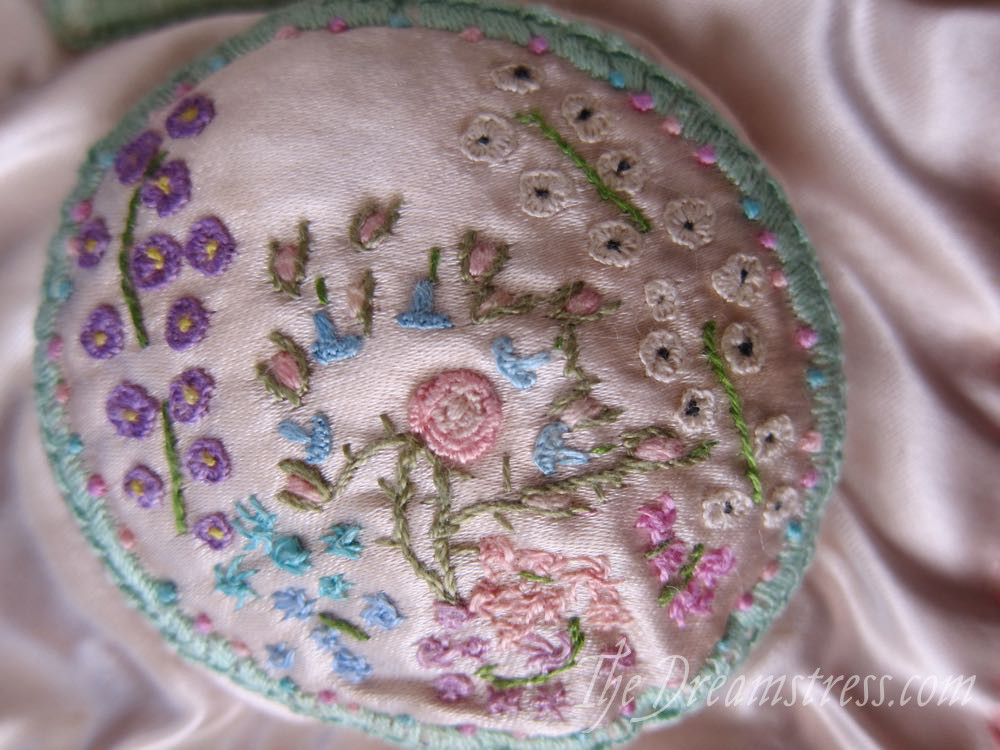
And a wee little pocket, possibly for a thimble:
And what I suspect is a bodkin holder:
Plus a buttoned pocket, and a bit of fabric for holding threaded needles, all covered with beautifully enthusiastic, if not necessarily particularly skilful, embroidery.
It also had three delicious secrets.
I bought the housewife just because I thought it was too wonderful to pass on, but when I got it home, I realised there were lumps in two of the pockets.
The first lump revealed itself to be a teeny-tiny cunning measuring tape. I’ve never seen one like it. You twist the sides to scroll the tape in and out, and can twist the numbers on either side (presumably to record the measurement while you work with it, so you don’t forget?)
The measuring tape is Made in England, and in inches.
The other secret is even better, and I missed it at first, and only noticed it when I was checking all the pockets to photograph them.
The buttoned pocket had a flat lump of paper in it, which I initially thought was just scrap. But I unfolded it, and it revealed two NZ sixpences:
One from 1934, and one from 1937:
What a find! I’d love to know the story behind it!

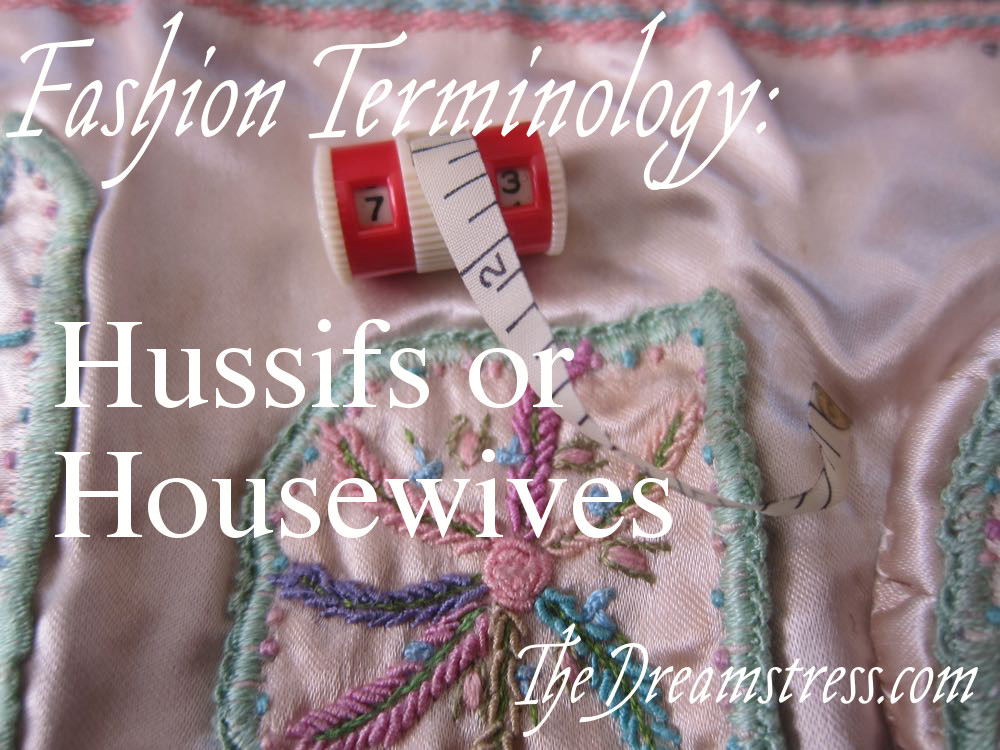
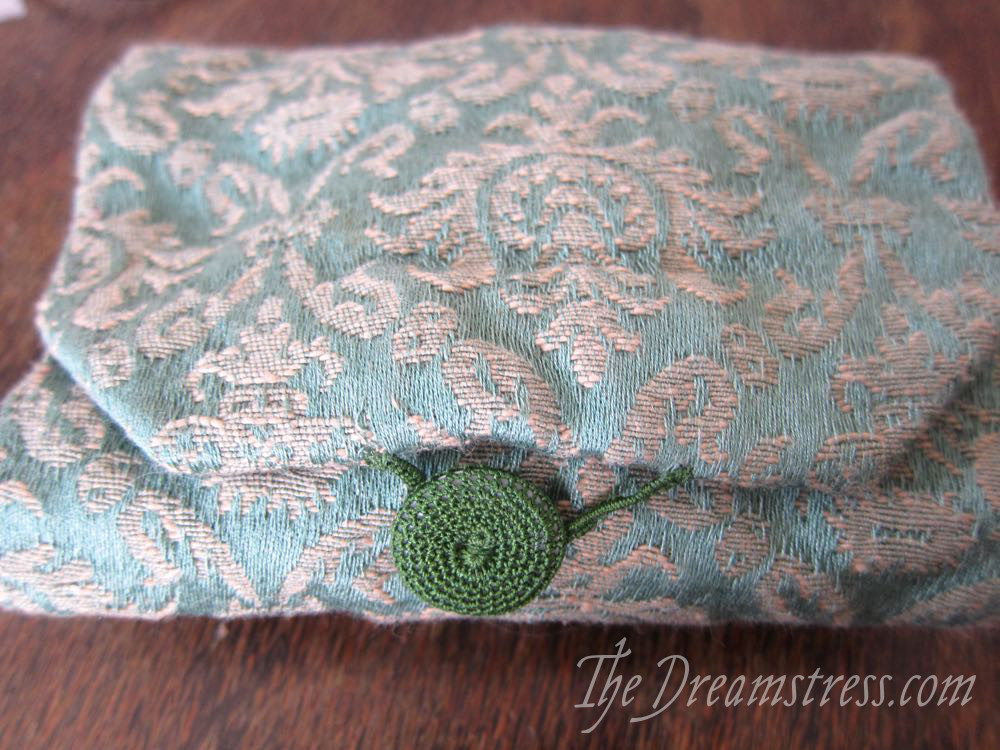
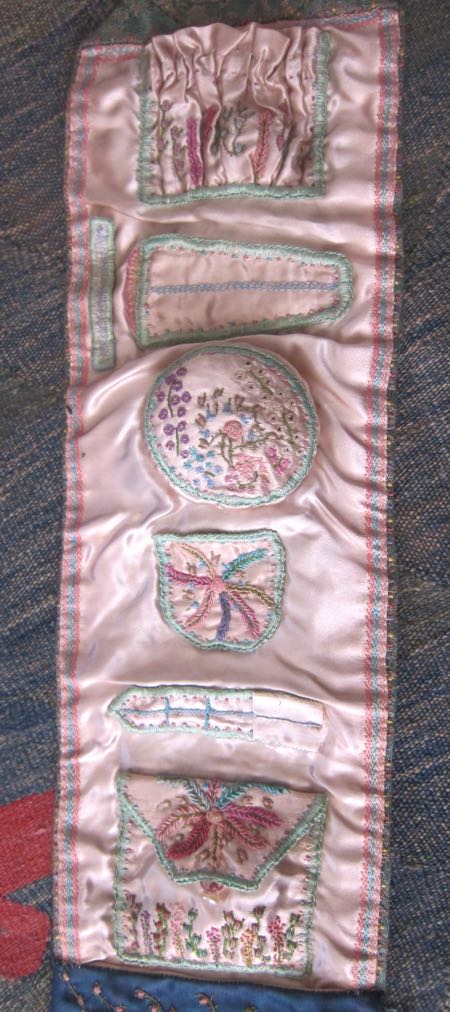
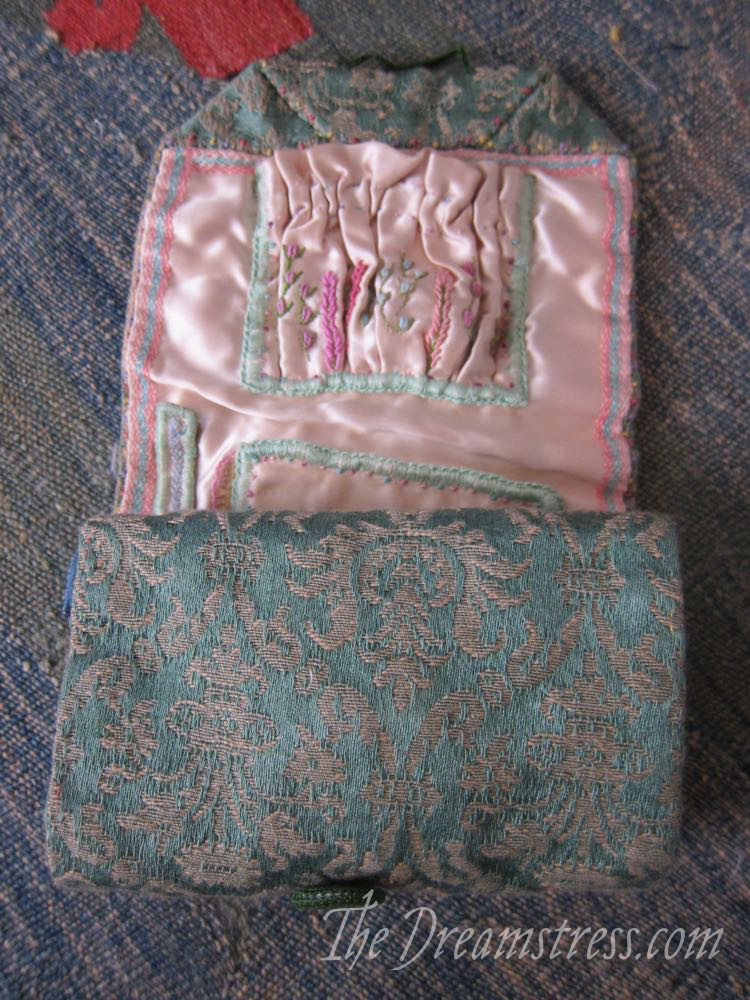
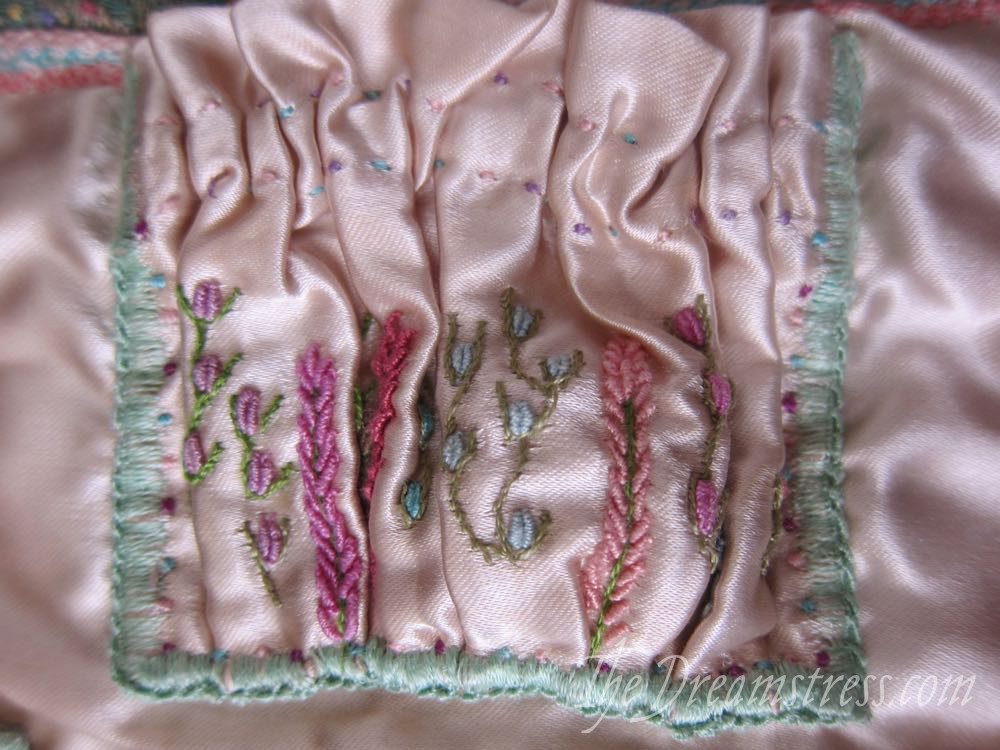
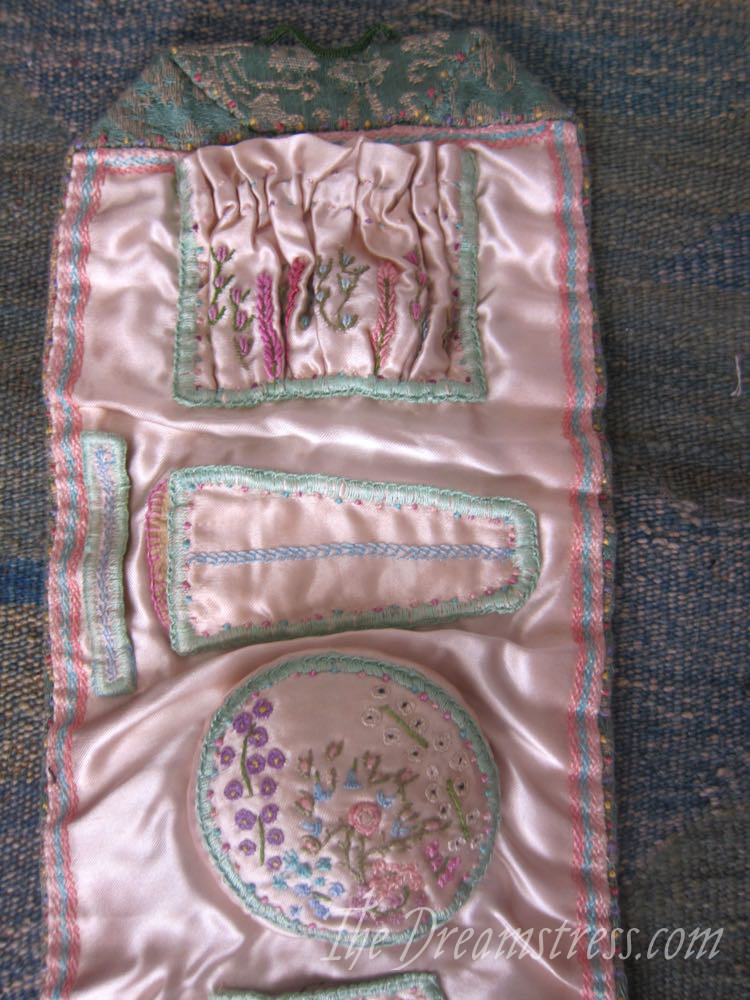
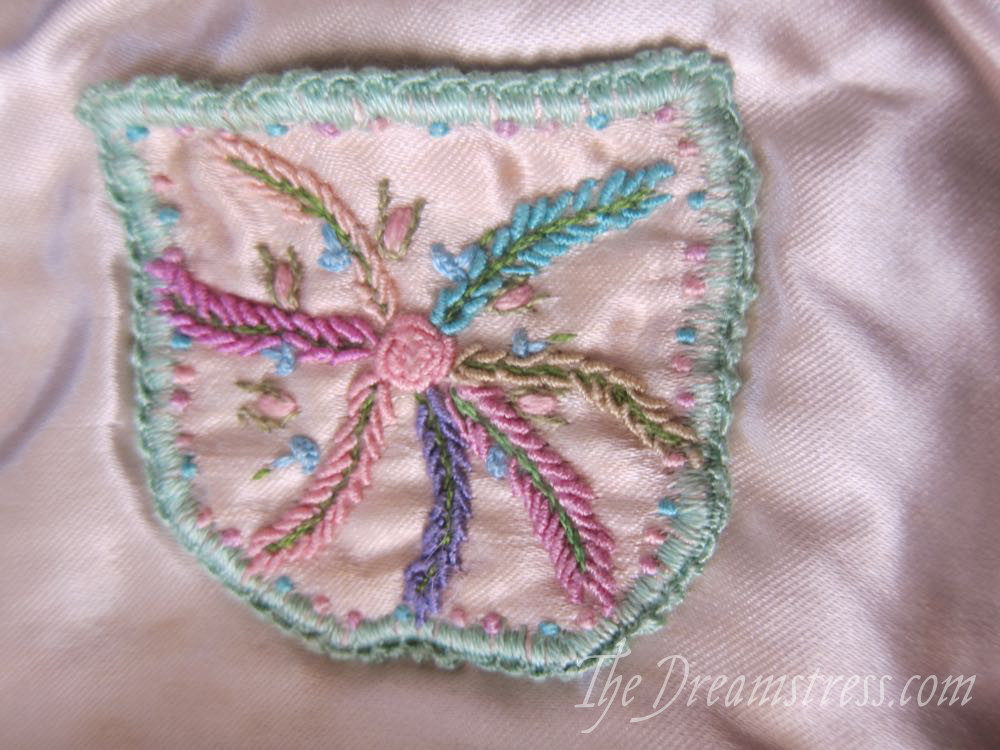
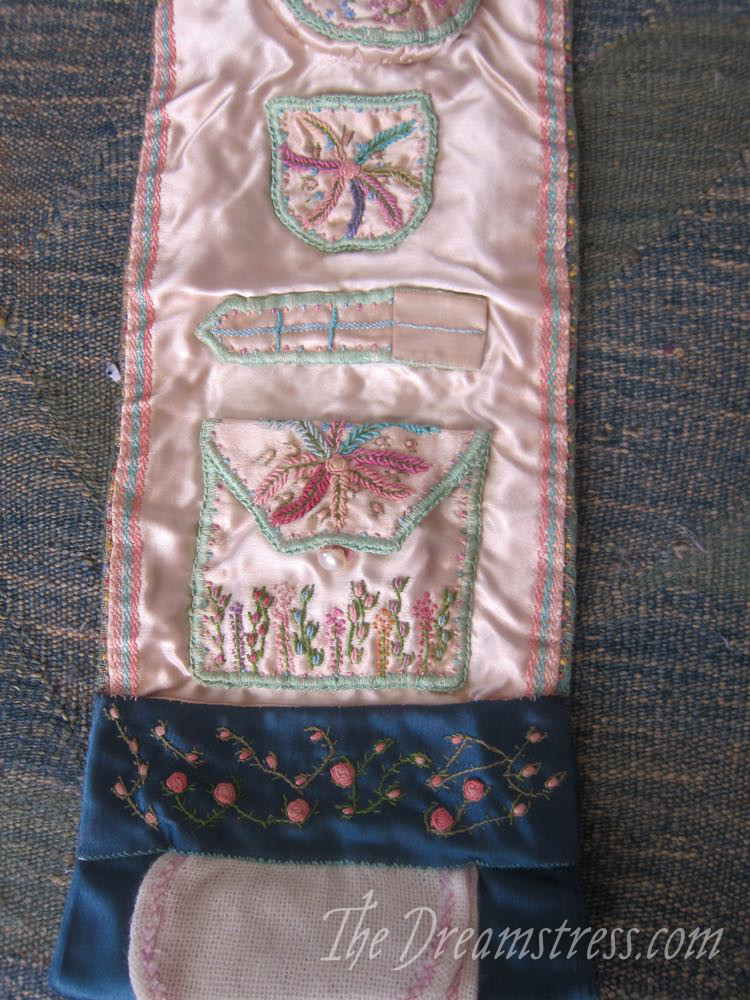
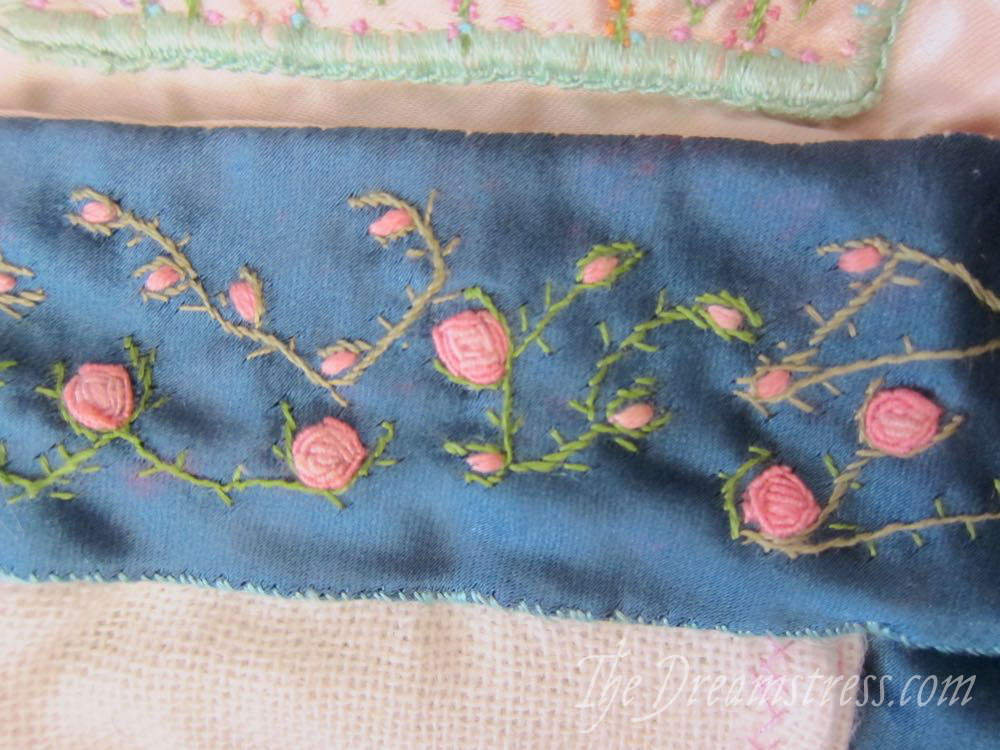
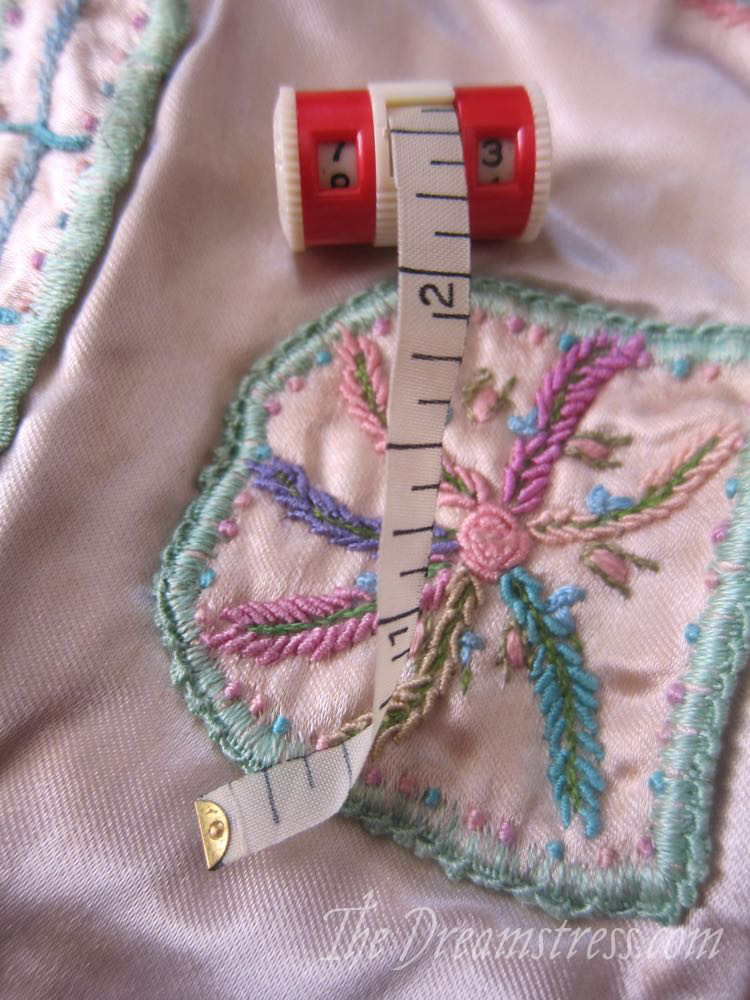
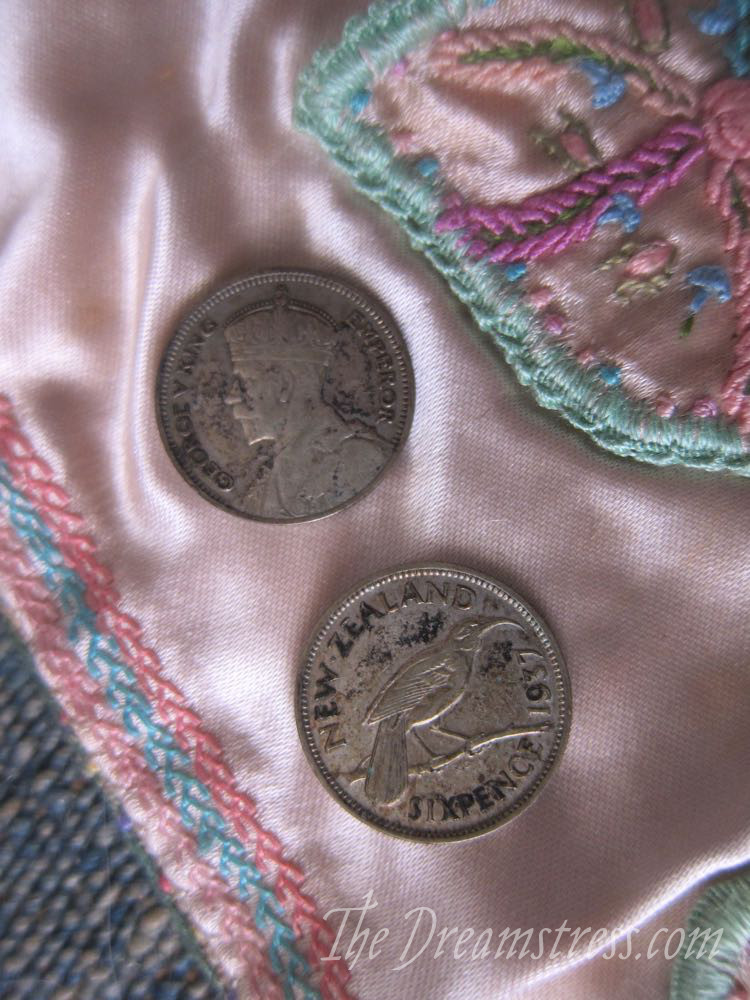
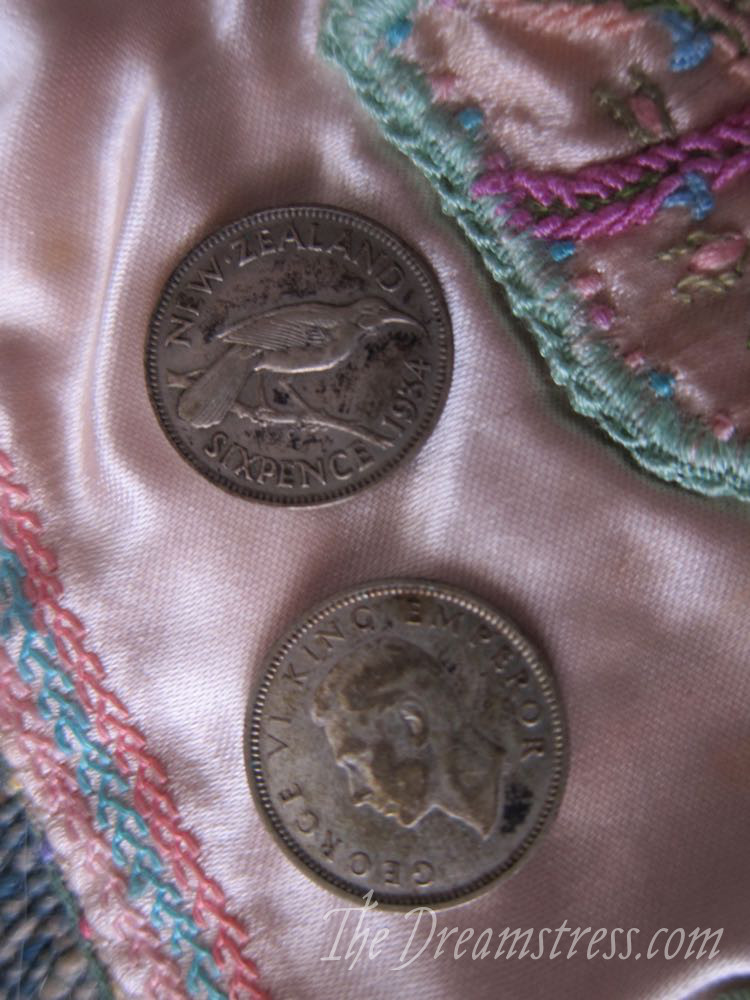
How beautiful! I love the pennies secreted away in the pocket.
Whilst it might be a bit odd in something presumably intended for sewing, I wonder if the tape measure could be intended for knitting? My grandmother row counter that looked very similar, although it didn’t have a measuring tape in it (which would have been very handy I imagine instead of having to have a separate measuring tape.)
I think it’s a row counter too. I’ve seen one like it before, with the little measuring tape.
The husband is a graduate of a US Service Academy–they are still issued “sewing kits’. They’re actually really super-neat, with ingenious ways of storing and organizing thread! Not as beautiful as this one, is, though. Very cool find!
Well I think you could assume the date of the piece from the sixpences. What a lovely find. And it is obviously lovingly made. But will you use it? When I was a girl we used to carry mini sewing kits in our handbags so that we could repair laddered tights. Nobody does that these days. How lucky you are.
I suspect the sixpences were lucky pieces – like the ‘sixpence in her shoe’ of the wedding rhyme, and so may be quite a bit older (traditionally you often use one from the year the bride was born, or even the year her mother was married). And I certainly have end up with American coins that are decades old on a regular basis when I am home (less common in NZ, because certain coins have changed), so older coins may happen a lot.
The measuring tape looks like a row counter for knitting. What a useful tool that would be! It would sell by the dozens if offered today.
Thanks for posting such a pretty find. It is so nice to know a new word for sewing kit.
Ah, that makes total sense! I don’t knit, so I forget about tools for knitting. Thank you!
What a lovely find! It is adorable 🙂 Interesting read, too. I always learn new stuff here. Thank you for sharing.
beautiful and inspiring little time capsule of memories
My father, a Korean War vet, kept his sewing kit from his military days. I was fascinated with it as a child and chose to use his sewing supplies over my mom’s, despite my mom being an accomplished seamstress. I vividly remember the OD green roll and all the supplies inside. And yes, the red item with the numbers looks a lot like my knitting row counter, although mine is modern and lacks the tape measure. I wish mine had one as I use a tape or gage regularly when knitting.
Three dollars? Seriously?!!! Wow! What an awesome find!
Three dollars for everything I could fit in a bag! Since this was only a fraction of a bag, they only charged me about 50 cents 😀
Oh, I want one! I’ve been intending to make one for a while now, I just can’t settle on a design…
Incidentally, what’s the difference between a hussif, a chatelaine and an etui?
Hussifs are soft fabric rolls with the sewing implements tucked into pockets. Chatelaines pin to your dress or hang from your belt, with the sewing implements (or containers for implements, including, possibly, an etui) hanging from them, and etui are small hard containers that can hold needles or other small sewing implements. Have you read my post on etui?
I have, yes. Thanks for delineating the distinct characteristics of the others. I can’t decide if I want to go for a hussif (presumably one could drape it over one shoulder as one works?) or a chatelaine. I like the idea of the chatelaine, but women’s clothing is seldom sturdy enough for hanging things off these days. Dilemma!
The nice thing about a hussif is that you can carry almost all your bits in it, and they are all fairly easy to access with it spread out, but with a chatelaine you have to unscrew the needle case (the etui), and it’s much harder to include things like measuring tapes and thimbles and a couple of safety pins etc. Since I teach sewing and am transporting my sewing all the time, a hussif is so much more practical.
How Adorable. Now I kinda feel like making an embroidered one to myself. <3
What a find! And it’s never been used, by the look of it. No pin-holes in the pincushion, no stretching of the pockets etc. And the tape measure and the sixpences are just the sort of things some kind person would tuck into a hussif that was to be a present. Possibly, it once had such things as tiny scissors, and other sewing supplies. Home-made, with pleasure and love. And treasured, if not used.
I think you are right about the date – the colours and style of the embroidery motifs suggest 1940s to me.
The sixpences are to go in bride’s shoes, right? “something old, something new, and a sixpence in your shoe”.
ceci
That was my thought as well, and if that’s the case it makes sense that the sixpences might not be the same age as the hussif.
This is sweet! The embroidery really makes it. And wonderful little surprises, too.
I agree that the little red and white object looks like a row counter (usually used for knitting and crochet), and measuring tape combined. It would be a good multi-tasking tool, especially for someone who practices more than one craft. The design for this type of row counter doesn’t seem to have changed much over the years. Even my modern ones look very similar, though they haven’t got the handy tape measure.
Also wanted to add, when my husband was in the US Air Force about 15 years ago, he was issued a little sewing kit. Just a little plastic/vinyl affair with some thread wrapped around a card, a couple of needles and safety pins,a few buttons and a little pair of not-too-sturdy scissors.
Forgot to say, that looks like a crochet-covered button and loop closing the huswif. I love a crocheted button. 🙂
It’s lovely! Thank you for writing about it. After a quick search I found an identical looking row-counter listed on Etsy as being from the 1960s- made in England. It looks as if this style perhaps slides onto the knitting needle.
Interestingly the Wikipedia article on “Row Counter (hand knitting)” mentions this model:
“The Compact rotary row counter was manufactured in England in the 1950s to 1960s under a pending patent application……The earlier version of the late 1950s to early 1960s had red numerals,[8] and the later 1960s version had black numerals.[9]”
Although I have always thought of these as a “row counter” it seems that many call the style that slips onto a needle a “knitting register.” I hope this isn’t too tangential. I think it is so useful and interesting to see different versions of handwork tools and understand what they are and were called. There are so many old handwork tools that I have seen that I just didn’t have a name for!
Oh awesome, thanks so much for finding that! I think that’s probably a better indication of the date of the hussif than the sixpences.
Not at all too tangential – I love it when my posts spark interesting discussions and more information! That is the absolute best part of blogging!
The military history reminded me of the German sewing magazines I have; the majority is WWII era, and one at least has things to sew for the men on the front… but not a hussif.
And now I wonder about the unseen and unmentioned intricacies of war. Could it be a repeat of the Crimean War? 😀
(It could be jumping to conclusions from little evidence and I don’t mean it that way. I just find it fascinating.)
And I should make myself one.
Exactly! It’s funny to think all the ‘female’ things that soldiers did, like mending and darning. The husband knows how to do it all. I do it better, though, but the point is that he was taught to do them as part of his military training–even in the present day.
Good score! I’m always happy when something as amazing as this falls into the right hands.
Thank you for sharing this, I would love to know the story too!
I still have my father’s hussif. He was in the RAFVR during WWII so it’s
@ 76 years old now…..reckon it’s due for a tub!
Very lovely! That is adorable and very delicate… Congratulations